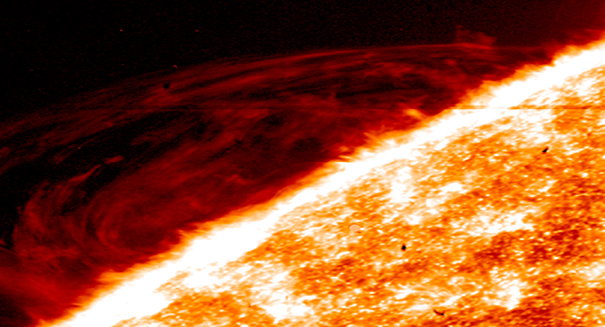
HD imaging technology provides NASA scientists with unprecedented access to solar events.
Not news: The sun is hot. But, as it turns out, certain regions of our closest star might be more active than scientists previously thought. The Interface Region Imaging Spectrograph, or IRIS, captured highly-detailed images of prominences in the sun’s atmosphere. The new image clarity is challenging the way scientists view solar events.
Solar observatories look at the sun in layers. By capturing light emitted by atoms of different temperatures, they can focus in on different heights above the sun’s surface extending well out into the solar atmosphere, the corona. IRIS was launched On June 27, 2013 to study what’s known as the interface region – a layer between the sun’s surface and corona that previously was not well observed. The mission’s early observations were presented at a press conference at the Fall American Geophysical Union meeting on December 9, 2013.
“The quality of images and spectra we are receiving from IRIS is amazing,” said Alan Title, IRIS principal investigator at Lockheed Martin in Palo Alto, Calif. “And we’re getting this kind of quality from a smaller, less expensive mission, which took only 44 months to build.”
IRIS is making it possible to study the explosive phenomena in the interface region in sufficient detail to determine their role in heating the outer solar atmosphere. Tracking the complex processes in the interface region requires instrument and modeling capabilities that are only now within our technological reach. IRIS captures both images and what’s known as spectra, which display how much of any given wavelength of light is present.
“We are seeing rich and unprecedented images of violent events in which gases are accelerated to very high velocities while being rapidly heated to hundreds of thousands of degrees,” said Bart De Pontieu, the IRIS science lead at Lockheed Martin. “These types of observations present significant challenges to current theoretical models.”
Two specific events are of particular interest to scientists. One is known as a prominence, which are cool regions within the interface region that appear as giant loops of solar material rising up above the solar surface. The second type of event is called a spicule, which are spectacular fountains of gas that zoom up from the sun’s surface at 150,000 miles per hour. IRIS imaging and spectral data allows scientists to see for the first time how spicules evolve. In both cases, observations reveal more complex processes than what existing theoretical models predicted.
“We see discrepancies between these observations and the models and that is great news for advancing knowledge,” said Mats Carlsson, an astrophysicist at the University of Oslo in Norway. “By seeing something we don’t understand we have a chance of learning something new.”
Leave a Reply